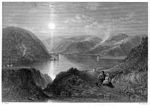Black Law (hill)
Donald mountainsMountains and hills of the Scottish BordersMountains and hills of the Southern Uplands

Black Law is a hill in the Manor Hills range, part of the Southern Uplands of Scotland. One of the more remote Donalds, it does not easily combine into a round with other hills in the area and requires traversing rough terrain to reach the top. Common ascents are as part of an extended Dun Rig Horseshoe to the north-east, from the south at the Megget Reservoir or, most easily, from the Manor Valley itself.
Excerpt from the Wikipedia article Black Law (hill) (License: CC BY-SA 3.0, Authors, Images).Black Law (hill)
Geographical coordinates (GPS) Address Nearby Places Show on map
Geographical coordinates (GPS)
| Latitude | Longitude |
|---|---|
| N 55.534422 ° | E -3.239942 ° |
Address
Scottish Borders
Scotland, United Kingdom
Open on Google Maps










